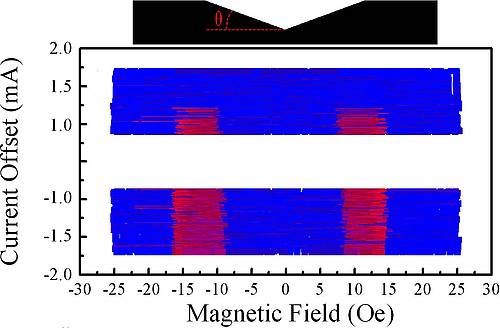Spintronics research at Leeds
Researchers at Leeds University (Physics) have demonstrated recently the linear dependence of the threshold current for current-induced domain wall movement with pinning potential strength.
NiFe half-bowtie structures (shown in figure) provide a restoring force on a domain wall trapped at the constriction, acting towards the centre of the constriction. The restoring force varies linearly with constriction angle as shown using micromagnetic simulations and by measuring the threshold current the relation between restoring force and threshold current is quantized.
The effect of currents above the threshold current is shown in the figure, where the discontinuation of the red bands indicate domain wall pinning suppression due to the current-induced domain wall movement effect. This allows for the determination of the threshold current for each constriction angle and the results have revealed a linear dependence of threshold current on constriction angle and hence restoring force.
These results should be significant for the development of spintronics devices utilising the current-induced domain wall movement effect.
This research is funded by the SPINCURRENT consortium, lead by Dr. Chris Marrows.

Half-bowtie structure showing definition of constriction angle and color-coded magnetoresistance measurements as a function of current offset. The red bands indicate domain wall formation. Suppression of red bands in one direction only indicates domain wall depinning due to current-induced domain wall movement.

